Cut your lawn … in half! So says the National Wildlife Federation. We went further than half.
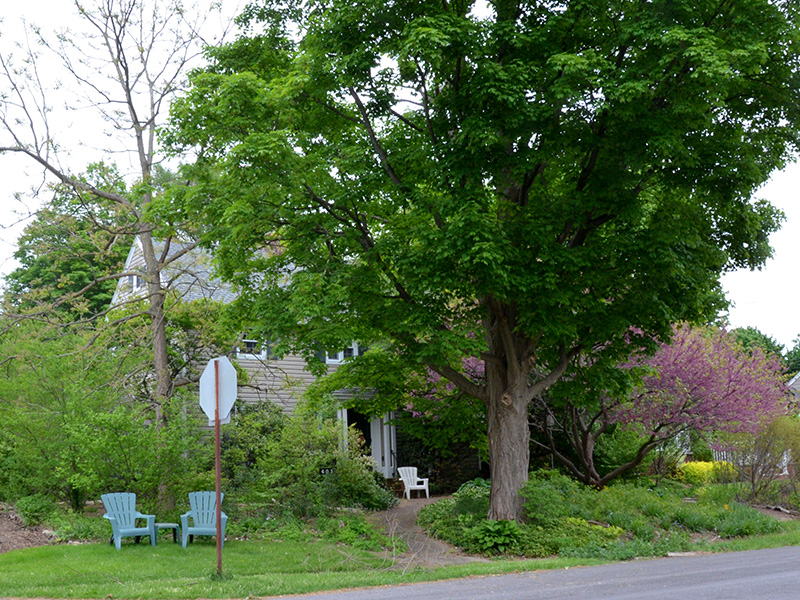
Why did we get rid of (almost) all of our lawn? Because it has virtually no habitat value. And to get that perfect, velvety, uniform carpet of green requires chemical fertilizers, pesticides, etc., etc. To keep it lush and green in the summer requires using valuable water. You have to rake the leaves in the fall so they won’t kill the lawn in the winter. And those lawn mowers and other power lawn equipment are noisy, heavily-polluting devices — more so than are cars!
AND it’s so boring!!!
Our front yard
We have a small lawn in front, but most of the front yard has trees, shrubs, planting beds, and a system of paths. We have no lawn at all in the back yard.
As you can see in our introductory photo above, our lawn is really just big enough to provide space for a few chairs and to show that organic, minimal lawn care actually works.
But lawn can serve a function: you can walk on it to get to different parts of your yard. Without lawn, what do you walk on to get around your yard?
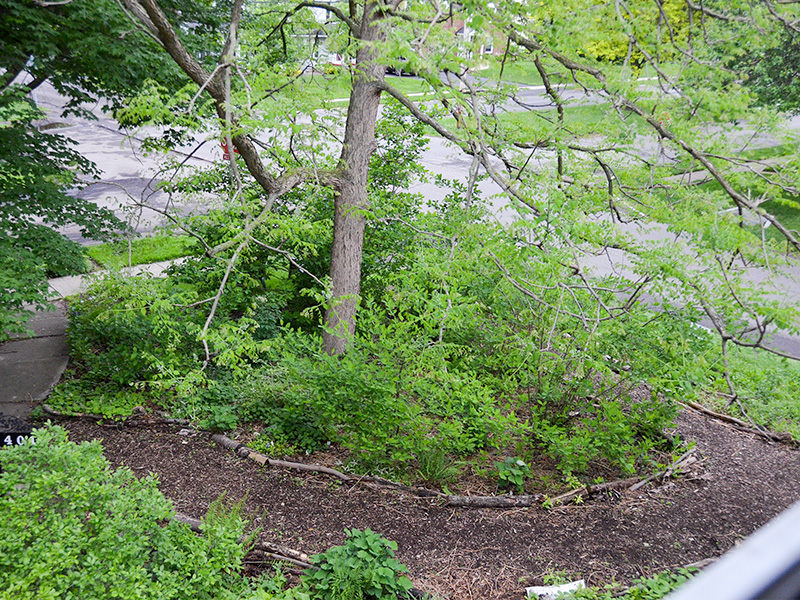
For us, the solution has been a network of paths. Originally we put landscape cloth on the paths and covered them with mulch from the county mulch pile, but we soon learned (as many other people have) that landscape cloth isn’t what it’s cracked up to be. It just doesn’t do much good. We pulled it all out (not as easy as laying it down originally), and now we just have a thick layer of wood chips. We replenish this mulch layer every few years.
Mulch has its own environmental costs, of course, but we have used the grindings from neighbors’ trees, used our county’s mulch pile, and have purchased locally-sourced mulch from a local company. CAUTION: Some people have found that purchased mulch can be a source of Asian jumping worms. If you can find it, buy sterilized mulch.
Our paths have worked out really well. All parts of our yard are connected, yet the maximum amount of useful, life-supporting plants are growing.
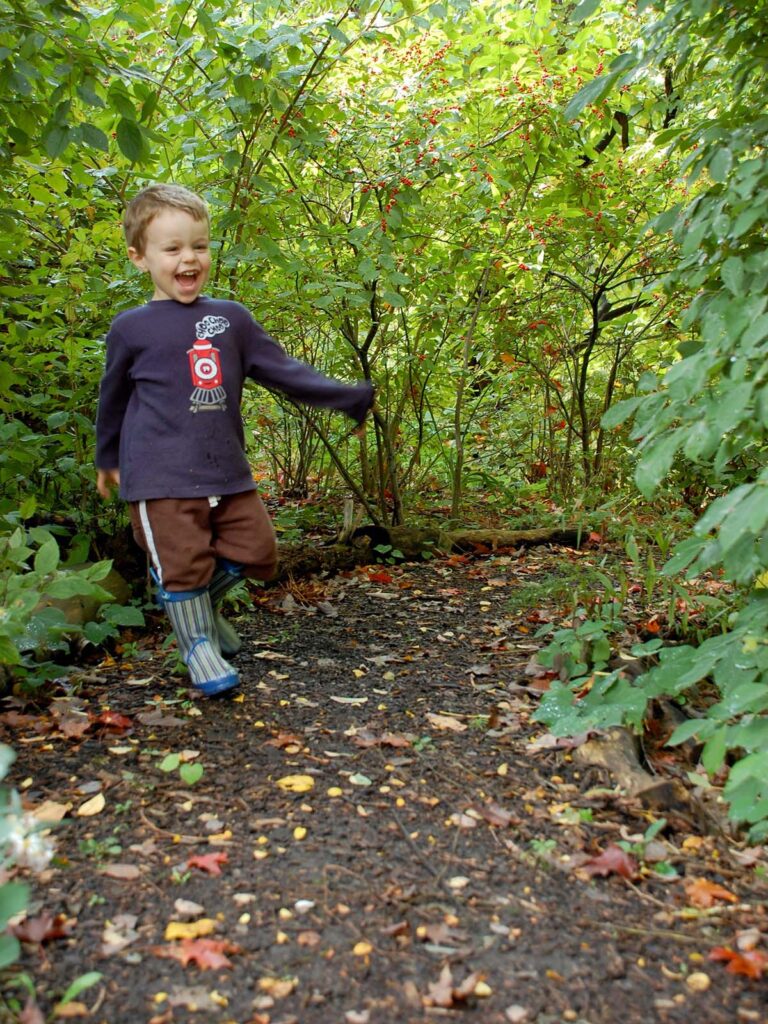
A bonus is that it’s very pleasant walking the paths through the flowers, shrubs, and trees. As more than one person has commented, it’s hard to believe you’re in the suburbs.
Clearly, our grandson enjoys it!
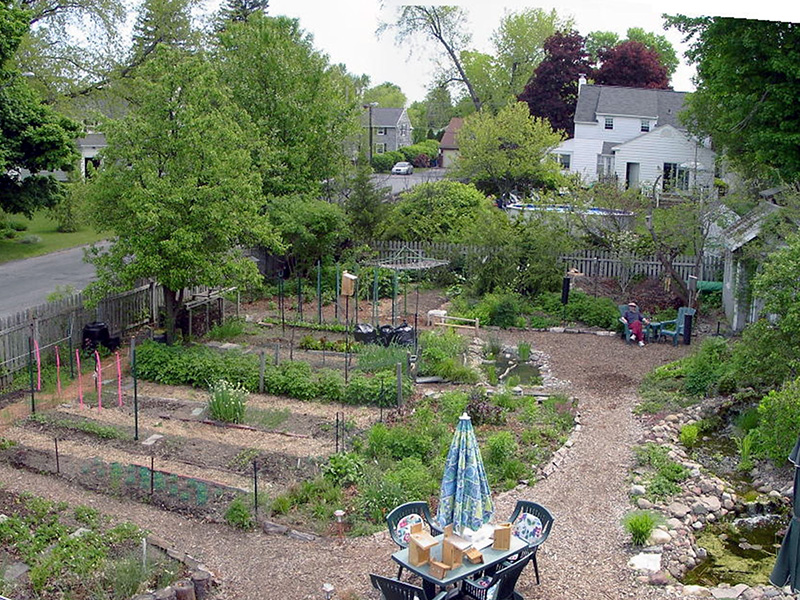
In the back yard, we have our edible garden, more habitat garden, and ponds — but no lawn at all.
We’ve been very happy with paths and larger mulch-covered sitting areas.
Getting rid of the lawn

This photo shows what our back yard lawn used to be.
How do you get rid of lawn? At first, when John (like many men for some reason) was still unwilling to give up lawn, I concentrated on frequently “neatening up the edges” — always in the direction of taking out more lawn of course (shown in this old photo of our back yard).
I call this the “Honey, I shrunk the lawn” approach!
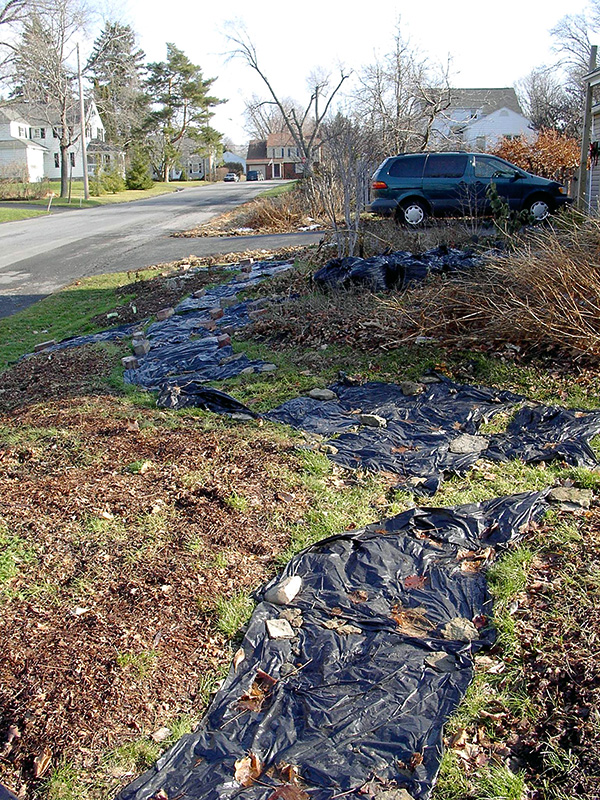
Later, when we intentionally went about getting rid of the lawn, we covered it with black plastic over the winter.
It wasn’t totally successful, but it made it easier to dig up the following spring. We saved all the sod and it became even more beautiful topsoil.

Too late I learned that the easiest way to get rid of lawn is to lay down thick sections of newspaper and cover it with many inches of mulch. Then they say you can plant right through it.
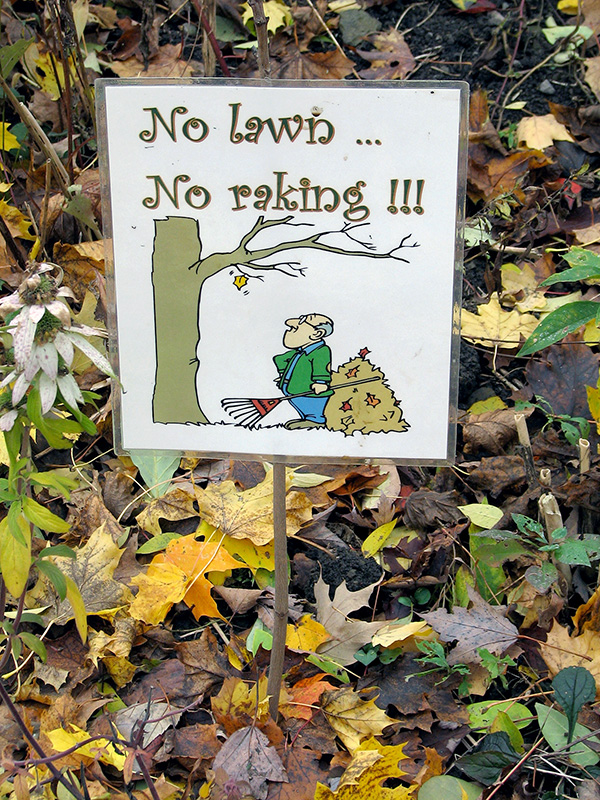
And one final benefit of having very little lawn is that it dramatically reduces the amount of raking needed in the fall.
Pretty much everything else except lawn does well with a natural blanket of leaves. In fact, not only does it do well, it’s really essential to having a healthy, biodiverse soil full of life!
Feel free to download and laminate my No Lawn, No Raking sign on my sign page.
Resources
- Homegrown National Park:
- VIDEO: Why is reducing the area of lawn important? – Short video by Doug Tallamy
- NY Times:
- Yes, you can do better than the great American lawn – great ideas for reducing lawn
- Ecological Landscape Alliance:
- Lawn murder – how the author eliminated much of her lawn; some good techniques!
- Lawn to meadow Season 3
- Less Lawn.com:
- LessLawn.com: Lots of suggestions about structuring your yard with less lawn
- Choose Natives:
- Penn State Extension:
- Pollinator Pathway:
- Pollinator Pathway has lots of resources, and encourages communities to start their own Pollinator Pathway. See if there’s one in your community — or start one! It grew out of Seattle’s Pollinator Pathway, which turned the hellstrip into a connected corridor for pollinators.
- ReScape / Bay Friendly:
- Garden Answer:
- VIDEO: How to remove sod
Reflections
Consider “reversing” the mulch in your yard. Instead of using mulch around plants, use leaves in gardens and reserve heavy mulch for walking paths.
~ Nesting and Overwintering Habitat from Xerces
… (I)t is the gardeners of the world who can open their gardens to the pollinator refugees, who can provide temporary or permanent shelter until humans refine our outlook on the natural world. By actively sheltering pollinators, we gardeners remind ourselves that we have the power to positively overcome some of humankind’s more destructive tendencies. Additionally, our gardens provide a teaching laboratory for young children to connect with an ever-vanishing natural environment. Our gardens might provide a network of urban and suburban biological corridors that link more protected sites and allow pollinators to move freely from one natural area via our gardens to other natural areas. And finally, all lofty, Earth-saving notions aside, you might wish to encourage pollinators in your gardens simply because they are more interesting than any television show you can imagine.
~ Eric Grissell, Insects and Gardens: In Pursuit of a Garden Ecology
Lately we have begun to recognize that we are poisoning ourselves with our lawns, which receive, on average, more pesticide and herbicide per acre than just about any crop grown in this country. Suits fly against the national lawn-care companies, and interest is kindled in “organic” methods of lawn care. But the problem is larger than this.
Lawns, I am convinced, are a symptom of, and a metaphor for, our skewed relationship to the land. They teach us that, with the help of petrochemicals and technology, we can bend nature to our will. Lawns stoke our hubris with regard to the land. What is the alternative? To turn them into gardens. I’m not suggesting that there is no place for lawns in these gardens or that gardens by themselves will right our relationship to the land, but the habits of thought they foster can take us some way in that direction.
~ Michael Pollan, Why Mow? The Case Against Lawns – The New York Times Magazine, May 28, 1989
